Contents
The fruits of sweet pepper contain a complex of vitamins vital for humans. The pulp is saturated with ascorbic acid, carotene, vitamin P and B. In addition, rarely is a dish complete without this vegetable. That is why the popularity of bell pepper is so high. To get a good harvest at home, you need to choose the right seed material. To help gardeners, we will try to identify the best varieties of sweet peppers, dividing them into groups according to the fruit ripening period.
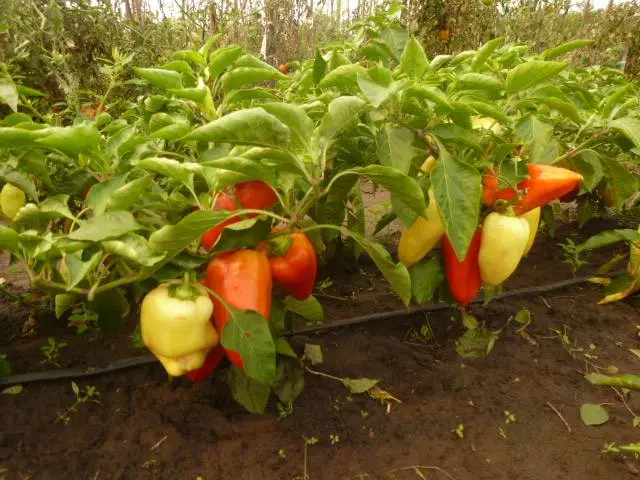
How to understand the variety of varieties
Before you figure out which crop seeds to choose, you need to consider a few important definitions. Bulgarian pepper is not only sweet fleshy vegetables. This group includes crops with sharp and bitter fruits. All varieties of peppers differ in the period of ripening. For cold regions, it is preferable to choose crops of early and mid-early ripening. They will bring good harvests in 80-90 days after seedling germination. Late ripening crops are best planted in the south. You can, of course, grow them in cold regions, but they will bring little harvest.
It is important to distinguish which seeds to buy for planting. There are varietal crops and hybrids. The latest types of pepper on the package are labeled F1. Hybrids are much more hardy than varietal crops, give large yields, and are less susceptible to diseases.
For gourmets who love to eat pepper in its raw form, whatever varieties are not suitable. Here it is better to give preference to crops that produce thick-walled fruits of white or yellow color. The size of mature peppers is important. For example, a small or medium vegetable is most often chosen for stuffing, large meaty peppers will go for lecho. The color of the fruit plays an important aesthetic role. Multi-colored peppers look appetizing canned in jars. That, in principle, is the whole main characteristic of a culture that an amateur vegetable grower should know.
The video tells how to choose the right varieties:
Overview of early varieties
Considering the sweet pepper varieties of the early ripening period, it must be said that they bring the best harvest in areas with a temperate climate. Numerous reviews of vegetable growers distinguish varieties “Orange Miracle”, “Atlantic”, “Rhapsody”, “Pinocchio”, “Winnie the Pooh”. However, early varieties are the best choice for cold regions, such as Siberia. For a short number of warm days, they manage to bring a good harvest. There are specially zoned Siberian varieties, for example, Topolin and Kolobok.
It is time to consider the best varieties of the early ripening period, which will help the photo and description of popular sweet peppers.
Lumina

Культура приносит перцы конусообразной вытянутой формы весом 120 г. Основной цвет зрелого плода белый, но в зависимости от состава почвы кожица приобретает разные оттенки, например, зеленый, розовый или желтый. Растение очень любит солнце, и чем больше лучей попадает на плоды, тем их окраска светлее. Овощ этого сорта не обладает особым ароматом, выделяющим его среди других перцев. Средней толщины мякоть обладает сладковатым привкусом.
This variety is popular with vegetable growers who grow crops for sale. The plant does without complicated care, feels good in open beds, brings a stable crop even with a lack of moisture. The harvested crop in dry cellars can be stored for about four months. From long-term transportation, sweet pepper retains its presentation. The purpose of the vegetable is universal.
Ivanhoe
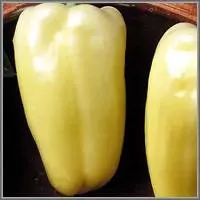
A fairly new variety of pepper has already managed to gain its popularity among many vegetable growers. The first harvest can be obtained 110 days after seedling germination. Unripe fruits have a white color of the walls, but even so they are tasty. As the vegetable ripens, it acquires red or rich orange flesh. Cone-shaped peppers with a pulp thickness of 6 mm weigh approximately 130 g.
Bull
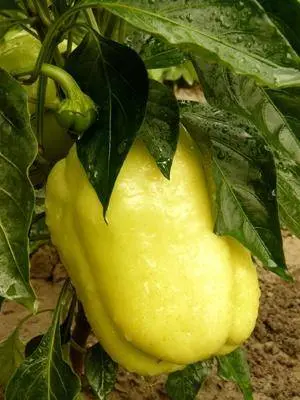
The culture produces fleshy yellow fruits. Peppers grow huge, some specimens weigh 500 g. The pulp is highly saturated with sweetish juice, which suggests the use of a vegetable for fresh salads and other dishes. It is not suitable for winter preservation. The plant is very powerful, up to 0,6 m high. The branches can independently support the weight of heavy fruits, but if possible, it is better to tie them up.
Health
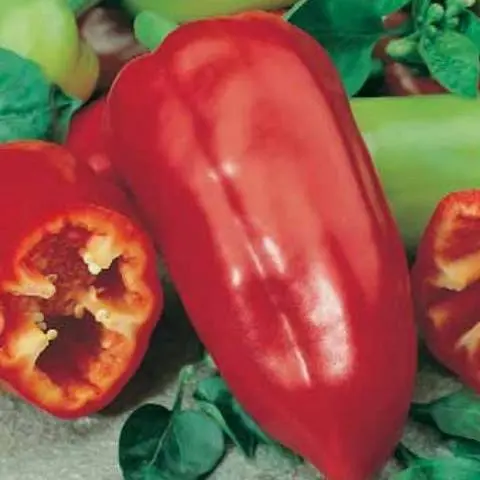
Для тех, кто любит маленький болгарский перчик, этот сорт будет как раз кстати. Конусообразные плоды подойдут для фаршировки, а также зимних заготовок. Мякоть овоща не толстая, но вкусная. На растении одновременно может завязаться до 15 перчинок.
Marinkin tongue
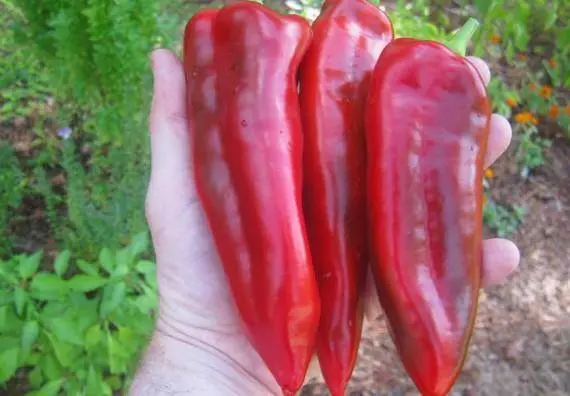
The culture is intended for cultivation on open beds. The birthplace of the variety is Ukraine. The plant perfectly adapts to sudden changes in climate, bringing a lot of crops at a time. Mature peppers are very fleshy and heavy, weighing about 200 g. In order for the branches of the bush to withstand such a weight, they are tied to a trellis or wooden stakes. The shape of the vegetable is elongated. As it ripens, the flesh turns red.
Apricot Favorite

The undersized plant brings stable yields in all weather conditions. Fruit size is medium, suitable for stuffing and winter preservation. The approximate weight of a mature vegetable is 150 g.
Tusk

A very tall plant requires a garter of branches to a trellis. Bushes can grow up to a maximum of 1,5 m in height. Medium thickness pulp has excellent aroma. Peppers are shaped like an elongated cylinder. As it ripens, the flesh turns red.
big papa
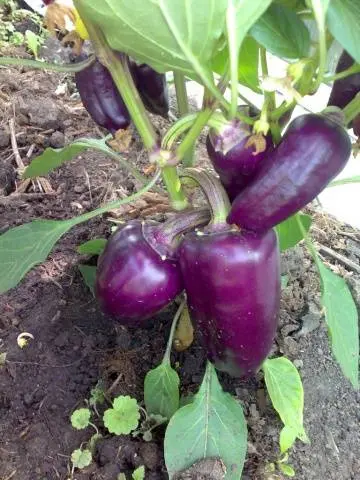
Этот сорт понравится любителям разноцветных перцев. После созревания стенки овоща могут приобретать красный или фиолетовый цвет. Растение имеет отличный иммунитет к разным вирусным заболеваниям. Урожайность стабильная высокая.
The Orange Miracle
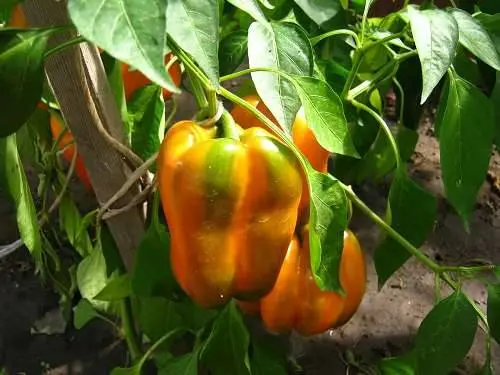
The plant is considered tall, as it grows to about 1 m in height. The bush is covered with medium-sized cube-shaped fruits. The walls of the peppers are fleshy and in order for the plant to withstand the entire crop, a garter to the trellis is necessary. A ripe vegetable acquires an orange color, an excellent aroma and a sweetish aftertaste. Great for salads and cooking lecho.
All these popular varieties of bell peppers have won success among amateur vegetable growers. Now, gradually, early varietal crops are being replaced by hybrids. Breeders instilled in them the best parental qualities of ordinary peppers. But the agricultural technology of hybrids is much more complicated, which is not always suitable for ordinary summer residents. Most of these peppers are intended for greenhouse plantings. The cost of seed material is much higher, and it will not work to collect it yourself on your site. The fruits of hybrids have a wide variety of shapes and colors.
Overview of mid-season varieties
Peppers of the middle ripening period are less in demand than early crops. Usually they bring less harvest, but are more suitable for conservation and other winter preparations. If we consider the best varieties of sweet pepper for regions with a temperate climate, then among them we can distinguish “Bogatyr”, “Red Knight”, “Golden Rain”. Even the cold climate of Siberia makes it possible to grow some mid-season varieties in shelters, for example, “Gift of Moldova”, and “Bogatyr”. Let’s find out which crops of the middle ripening period vegetable growers consider the best.
Gift of Moldova

One of the most popular varieties for any region. The plant perfectly adapts to any climate, tolerates heat, cold and slush, is not demanding on the composition of the soil. The culture has good immunity to diseases, brings stable large yields. If the climate permits, bushes are best grown outdoors. A vegetable is considered a salad direction. Cone-shaped peppercorns weigh about 90 g. The pulp of medium thickness turns red when ripe. The harvested crop perfectly tolerates storage and transportation.
cherry pepper
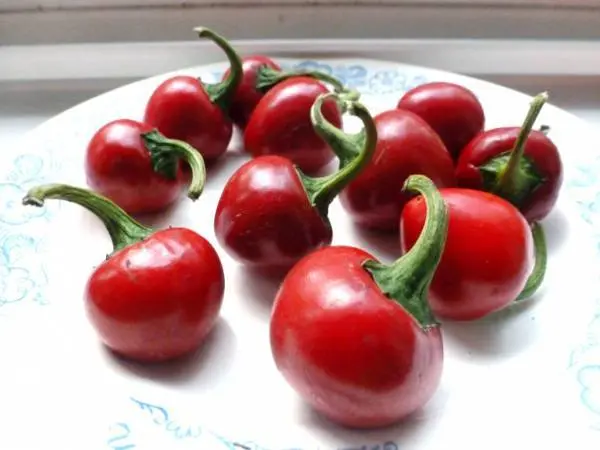
A very productive crop produces small fruits. A small pepper is more in demand for conservation. As the vegetable ripens, it may turn yellow or red. The pulp of the fruit contains a lot of trace elements, vitamins and other useful substances that are vital for human health.
Purple Othello F1
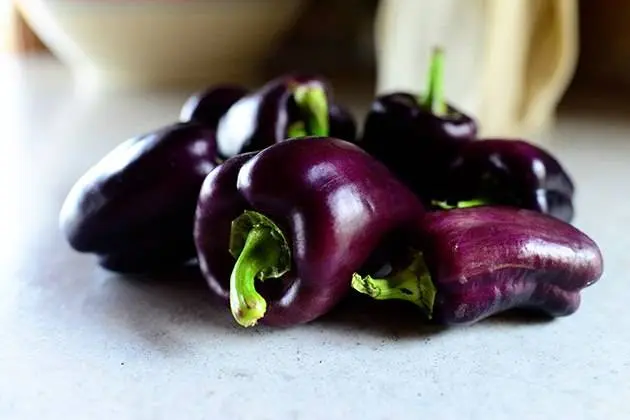
The hybrid has a high and powerful bush structure. The cone-shaped sweet pepper is medium in size, great for salads, can be stuffed. The purple color of the pulp appears at the first stage of ripening. A fully ripe vegetable turns brown.
Chinese varieties belong to the middle ripening period. Most of them bear fruits with a sharp taste. Many people confuse this vegetable with the hot Chile variety. The fruits of colored Chinese varieties are very beautiful. Their color palette has a wide range.
Overview of mid-late varieties
It is not customary to grow sweet peppers of late varieties in cold regions due to the fact that they simply do not have time to bring the harvest. Some Siberian lovers plant them in greenhouses. Cultures of the late ripening period are optimally suited to the southern regions. They bring a fresh harvest until the onset of frost. Moreover, the cultivation of late varieties is preferable here in open beds. Good reviews have varieties “Albatross”, “Anastasia”, as well as hybrids “Nochka”, “Lyudmila”. Let’s take a closer look at some popular late-ripening varieties.
Paris F1
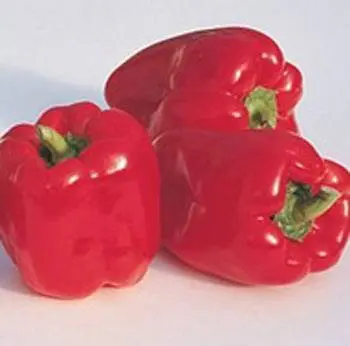
The hybrid belongs to the mid-late period of maturation. The bush grows a maximum of 0,8 m in height. Productivity is high, from 1 m2 you can collect 7 kg of peppers. Cube-shaped fruits turn red when ripe. The hybrid can be grown in closed and open beds.
Night F1
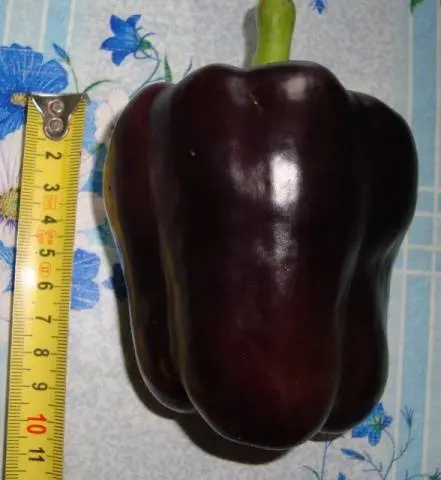
Another popular hybrid belongs to the mid-late ripening period. A very beautiful bush is densely covered with small cube-shaped peppercorns. When ripe, the fruits turn red like lights. The largest vegetable can grow weighing 100 g. The yield of one plant is 3 kg. Growing a hybrid is possible in open and closed ground.
Gamik

The culture of the mid-late ripening period perfectly bears fruit in the open air and in the greenhouse. Low bushes of compact size are densely covered with small peppercorns. The mass of the vegetable is only 40 g. The pulp is thin, about 3 mm thick. Peppers turn orange when ripe.
Oreni F1
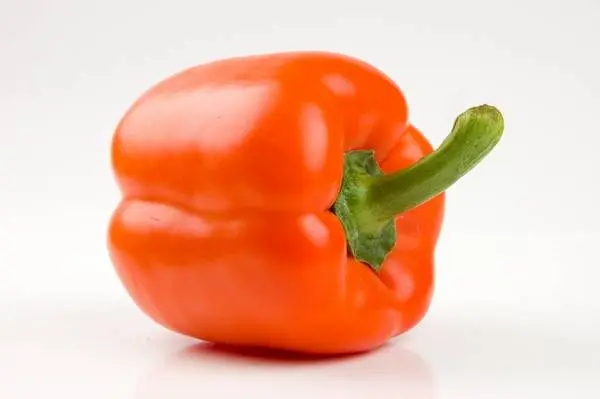
This hybrid is adapted for greenhouse cultivation. The undersized plant itself forms a compact bush. Cuboid-shaped peppers with a pulp thickness of 6 mm become orange when ripe, while they have excellent taste. Vegetables are used more for salads. The harvested crop is stored for a long time and endures long transportation.
The video provides an overview of pepper varieties:
Varieties of capsicum
When talking about capsicum, many people mean by this name only bitter fruits. In fact, capsicum is of two types:
- The first type really refers to hot peppers. One of the popular varieties is the well-known “Chili”.
- The second type is represented by sweet bell pepper. It is also called paprika. Fruits of different varieties differ in taste, aroma and are most often used as a dried seasoning.
Paprika brings most often a long cone-shaped pod with a pulp thickness of 1–3 mm. The fruit is quickly able to dry out in the sun, after which it is crushed into a powdery state. There are five main varieties of paprika.
Pomegranate
The culture of the middle period of ripening brings sweetish aftertaste fruits weighing 35 g. The undersized bush grows a maximum of 45 cm in height. The walls of the vegetable have longitudinal ribbing. A fully ripe pod turns red. The thickness of the pulp is from 1,5 to 3,5 mm.
Hedgehog
A variety of medium ripening period brings a crop, 145 days after seed germination. The bushes are very low, densely covered with foliage. Very small fruits are formed on the branches, shaped like hearts. A ripe vegetable weighs about 18 g. When ripe, it becomes a rich red color. The maximum length and width of the pepper is 4.5 cm. The plant bears fruit well in a flower pot on the window.
Cascade
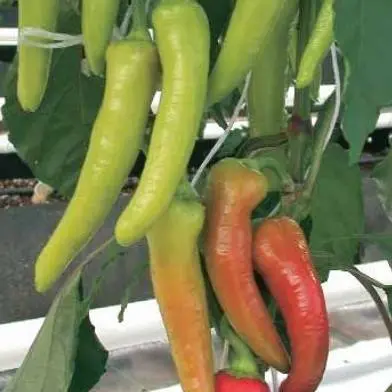
Паприка среднего периода созревания приносит урожай примерно через 115 дней после прорастания семян. Где-то на 140 день перцы полностью вызревают и становятся красными. Кусты немного раскидистые без плотного покрытия листвой. Максимальный вес овоща 55 г. Стручки изогнутой формы вырастают длиной около 18 см. Мякоть обладает отменным ароматом и вкусовыми качествами. Кроме приготовления сухих приправ, стручки используют для консервации.
Baby
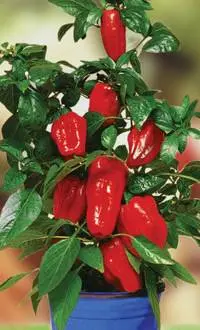
The plant of the average fruiting period brings the first crop in 140 days. Low-growing bushes do without a garter of branches. The cone-shaped pods grow evenly with a smooth skin. With a maximum length of 10 cm, the pod weighs about 38 g. The ripe color of the vegetable changes from purple to red. The pulp of the vegetable contains a lot of vitamin C. The pods are consumed fresh, as a seasoning and for preservation.
Lighthouse
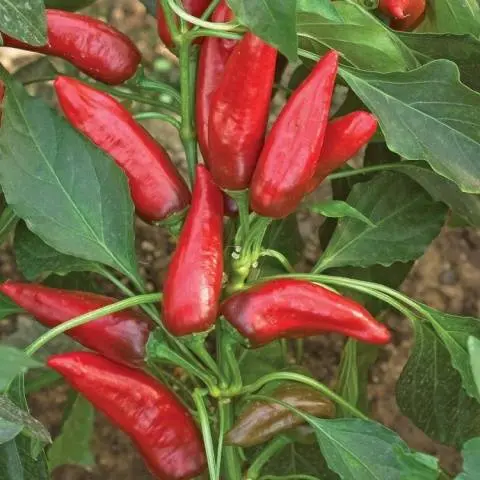
This variety of paprika belongs to the early ripening group of peppers. The appearance of the first crop is observed 125 days after seedling germination. Low growing shrubs are moderately leafy. Thin cone-shaped pods with a maximum length of 13 cm weigh 25 g. Red-colored pulp contains a lot of ascorbic acid. The pods are used to make dry seasonings.
Conclusion
Сегодня мы постарались рассмотреть лучшие семена сладкого перца, по мнению дачников и овощеводов. Хотя такое определение каждый овощевод подразумевает по-своему и выбирает для себя свои лучшие сорта.









